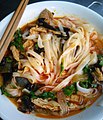 A bowl of Mì Quảng with pork and egg A bowl of Mì Quảng with pork and egg | |
| Type | Noodle |
|---|---|
| Course | Main course |
| Place of origin | Vietnam |
| Region or state | Quảng Nam Province |
| Associated cuisine | Vietnam |
| Serving temperature | Warm |
| Main ingredients | Rice noodles, shrimp or pork or chicken (sometimes fish or beef), various herbs |
| Ingredients generally used | Turmeric, peanuts, toasted sesame rice crackers, chili peppers, lime |
Mì Quảng (also spelled mỳ Quảng), literally "Quảng noodles", is a Vietnamese noodle dish that originated in Quảng Nam Province in central Vietnam. It is one of the region's most popular and well-recognized food items, and is served on various occasions, such as at family parties, death anniversaries, and Tết. It is a common food item in Ðà Nẵng and the surrounding regions, where it is eaten at any time of day.
Ingredients and serving
The main ingredients of mì Quảng are rice noodles, meat, and herbs, most commonly served with a small amount of broth, which is generally infused with turmeric. Peanut oil can also be added to make the dish more flavorful. Wide rice noodles are placed atop a bed of fresh herbs in a bowl (or vice versa), and then warm or lukewarm broth and meat are added. The broth is usually strongly flavored and only a small amount of it is used, generally enough to partially cover the vegetables.
Meats used in the dish may include one or more of the following: shrimp (tôm), pork (thịt heo), chicken (gà), or even fish (cá) or beef (bò). The broth is made by simmering the meat in water or bone broth for a more intense flavor, seasoned with fish sauce, black pepper, shallot and garlic. Turmeric is often added to the broth, giving it a yellowish color.
As with many Vietnamese dishes, mì Quảng is served with fresh herbs (rau); commonly used herbs include Thai basil, cilantro (ngò or rau mùi), scallions or onion leaves, Vietnamese coriander (rau răm), sliced banana flower (bắp chuối bào), and lettuce. A variety of other herbs may also be used in mì quảng, including common knotgrass (rau đắng), water mint (rau húng lủi), perilla (rau tía tô), and heartleaf (rau diếp cá).
Mì Quảng is commonly garnished with peanuts and toasted sesame rice crackers called bánh tráng mè, which sets the dish apart from other noodle dishes. Additional ingredients may include hard-boiled quail eggs, steamed pork sausage (chả), or shredded pork rinds (tóp mỡ). Lime juice and fresh chili peppers are often used as an added seasoning; other seasonings may include soy sauce or chili sauce.
Mì Quảng can also be served without broth, as a salad (mì Quảng trộn).
-
 Served with pork, shrimp and toasted bánh tráng mè
Served with pork, shrimp and toasted bánh tráng mè
-
 Served with pork, shrimp and yellow turmeric-dyed noodles
Served with pork, shrimp and yellow turmeric-dyed noodles
-
 Served with pork, shrimp and prawn crackers (bánh phồng tôm)
Served with pork, shrimp and prawn crackers (bánh phồng tôm)
-
 Served with snakehead fish (cá lóc)
Served with snakehead fish (cá lóc)
-
 Vegetarian mì Quảng with imitation meat
Vegetarian mì Quảng with imitation meat
Cultural aspects
There is a Vietnamese saying about this dish:
Thương nhau múc bát chè xanh,
Làm tô mì Quảng mời anh xơi cùng.
This couplet describes a girl from Quảng Nam, a province on Vietnam's South Central Coast, who warmly invites her lover to drink a cup of tea and a bowl of mì Quảng, to show him the depth of her love for him.
See also
Notes
- Le, Helen (29 February 2012). "Mi Quang - Quang Noodle with Pork and Shrimp". Helen’s Recipes Official Website. Retrieved 5 July 2024.
- "Mì Quảng - 3 cách nấu SIÊU HẤP DẪN chuẩn vị miền Trung". vinpearl.com (in Vietnamese). Retrieved 2024-05-18.
- ^ Le, Helen (2014-08-01). "Quang-style noodle with pork and shrimp: Mỳ Quảng tôm thịt". Vietnamese Food with Helen's Recipes. Helen Le. pp. 25–27. ISBN 9781500529710.
- ^ Hesser, Amanda (2010-10-25). "Mi Quang (Rice noodles with shrimp, herbs, and fried pork rinds)". The Essential New York Times Cookbook: Classic Recipes for a New Century. W. W. Norton & Company. pp. 609–611. ISBN 9780393247671.
- ^ Fay, Kim (2010). "Someone Else's Favorites". Communion: A Culinary Journey Through Vietnam. ThingsAsian Press. p. 137. ISBN 9781934159149.
- Le, Helen (2017-10-03). "Quang-style noodle salad". Simply Pho: A Complete Course in Preparing Authentic Vietnamese Meals at Home. Race Point Publishing. p. 141. ISBN 9781631063701.
- Nguyễn Hữu (2019). Làm tô mì Quảng mà thương nhau cùng. Thanh Nien News. 2019-02-01. Accessed 2024-01-13.
- Tiêu Phong (2011). Ăn mì Quảng để nhớ quê nhà. VnExpress. 2011-12-15. Accessed 2024-01-13.
References
- Hesser, Amanda (2010-10-25). "Mi Quang (Rice noodles with shrimp, herbs, and fried pork rinds)". The Essential New York Times Cookbook: Classic Recipes for a New Century. W. W. Norton & Company. pp. 609–611. ISBN 9780393247671.
- Le, Helen (2014-08-01). "Quang-style noodle with pork and shrimp: Mỳ Quảng tôm thịt". Vietnamese Food with Helen's Recipes. Helen Le. pp. 25–27. ISBN 9781500529710.
- Le, Helen (2017-10-03). "Quang-style noodle salad". Simply Pho: A Complete Course in Preparing Authentic Vietnamese Meals at Home. Race Point Publishing. p. 141. ISBN 9781631063701.
| Noodles | |||||||||||||||||||||||||||||
|---|---|---|---|---|---|---|---|---|---|---|---|---|---|---|---|---|---|---|---|---|---|---|---|---|---|---|---|---|---|
| Variants |
| ||||||||||||||||||||||||||||
| Dishes |
| ||||||||||||||||||||||||||||
| Instant noodle brands | |||||||||||||||||||||||||||||
| List articles | |||||||||||||||||||||||||||||
| See also | |||||||||||||||||||||||||||||